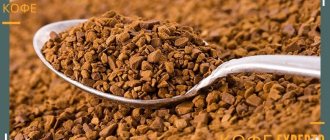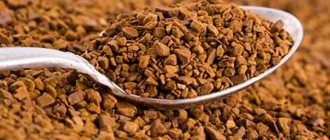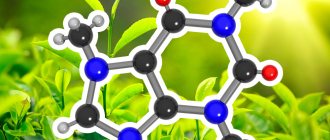Coffee is the most popular natural drink, which has a rich composition. It consists of numerous structural elements of organic and inorganic nature, affecting the human body in different ways. Freshly roasted coffee beans contain about a thousand different chemical compounds. So what does coffee contain and what effect does it have?
What do coffee beans contain?
The chemical composition of coffee beans includes more than 1000 compounds of organic and inorganic origin. Most of the substances perform biological roles: they have a direct effect on the human body, act as precursors of other complexes, and participate in enzymatic reactions.
The types of compounds and their relative quantities depend on the type of coffee, the degree of maturity of the grain, and the stages of subsequent processing. Internal chemical interactions occur at the stages of production of the final product, leading to the destruction of some substances and the formation of new components.
Original coffee beans contain:
- alkaloids;
- organic acids;
- tannins;
- amino acids;
- carbohydrates;
- vegetable proteins;
- lipids;
- vitamins;
- microelements;
- macroelements.
Each group of compounds has its own meaning. Often the actions of the components turn out to be opposite, which introduces some contradictions in opinions about the effects of the product. The study of what coffee contains and in what proportions continues. Research is being carried out and attempts are being made to artificially synthesize the unique complexes contained in coffee.
Fair Trade, Direct Trade, Rainforest Alliance…
(Fair Trade, Direct Trade, Tropical Alliance)
There are many certifications in the coffee industry, and it can sometimes be difficult to understand what each one means.
First, let's look at the most famous of them: the FAIRTRADE certification system (Fair trade label). It means that grain producers (farmers) receive a certain amount in addition to the international price of coffee. However, this does not necessarily mean a living wage.
UTZ certification means that producers are trained in best farming practices to improve the quality and yield of coffee. As a result, farmers receive more income.
Next is the DIRECT TRADE certification system (direct trade). This is actually a trade model, not a certification program; however, many roasters who use this model will say that it provides consistency in production. It involves the purchase of grain by roasters directly from farmers. These coffees are typically of exceptional quality, and many roasters work with growers to provide additional feedback and support in improving the quality of the crop.
Typically, roasters pay much more than the international coffee price and often more than UTZ and Fairtrade farmers receive in the commodity market. However, some criticize this trading model, arguing that it is not regulated and can only be a marketing one. Unlike the Fairtrade and UTZ programs, in this case it is difficult to know how much the producer actually received for his crop.
The Rainforest Alliance label means that the coffee has been grown in environmentally friendly conditions, minimizing damage to local forests and waterways. Similarly, Bird Friendly Coffee certification denotes organic coffee that supports the growth and restoration of local forests and, as a result, helps local wildlife thrive.
Alkaloids
The group of alkaloids includes biologically active plant substances endowed with the ability to influence the functioning of organs and systems of animal organisms. These are potent nitrogen-containing complexes, many of which are classified as toxic compounds.
- Caffeine
Caffeine is the main alkaloid in coffee beans. The amount of substance in the dry residue reaches 2.5% of the total mass. For a potent compound, the share is impressive, so natural coffee drinks are the leaders among caffeine-containing products.
Caffeine is classified as a psychostimulant, due to its ability to stimulate the central nervous system, accelerate the conduction of nerve impulses while simultaneously blocking relaxation receptors.
Main effects of caffeine:
- toning the human body and increasing performance;
- stimulation of muscle fibers;
- acceleration of metabolic processes, including the metabolism of fats and uric acid;
- increasing the speed of reactions at the brain level.
Coffee beans with caffeine stimulate the activity of the heart and blood vessels, cause an increase in heart rate, spasm blood vessels and provoke an increase in blood pressure.
The effects are temporary, but in the presence of diseases of the heart, blood vessels, and nervous system, the likelihood of negative consequences increases. It is not recommended to drink coffee in large doses, exceeding two cups of drink per day.
Abuse of coffee drinks can lead to addiction, manifested by increased irritability, aggression and other behavioral disorders.
- Theobromine
Sometimes, after drinking a cup of coffee, instead of the expected invigorating effect, you feel drowsy. The question arises: what is contained in coffee besides caffeine, endowed with other properties.
The alkaloid theobromine is localized in the central part of the coffee bean and acts opposite to caffeine. The substance does not stimulate the nervous system, but has a calming effect. The ratio of alkaloids of different directions determines the final effect of drinking the drink: invigorating or sedative.
- Theophylline
Theophylline stimulates respiratory function. Makes breathing easier and reduces the severity of episodes of shortness of breath. Helps increase heart rate and stimulates cardiac activity.
- Trigonelline
The compound does not have such strong effects on the human body, but it is trigonelline that gives the drink its unique taste. During roasting, the substance breaks down into aromatic compounds that give the drink a characteristic, recognizable smell.
Chemical composition of raw coffee beans
The biochemical formula of coffee is quite complex. The basis of the green product is water, fiber and oils. Coffee beans also contain the following components:
- caffeine;
- chlorogenic acid (gives the drink an astringent taste);
- mineral salts;
- theobromine;
- protein;
- trigonelline (during frying it contributes to the appearance of a characteristic aroma).
At least fifty percent of the composition of green grains is carbohydrates. With their help, it is possible to obtain a characteristic crema in espresso. They are the basis of the drink. It also contains a lot of acids that begin to release during heat treatment. They have a positive effect on the digestive system and the functioning of the stomach.
With the help of tannins, it is possible to obtain an astringent, bitter taste. When milk or cream is added to the drink, the structure changes and the bitterness is partially eliminated.
The caffeine contained in the beans has an invigorating effect, stimulates the activity of all systems and slightly increases blood pressure. Depending on the variety, the concentration of the alkaloid is different. It has been noted that there is more caffeine in Robusta than in Arabica. In addition, the amount of the substance depends on the method of processing the product and the growing region.
The beans also contain coffee ash, which consists of manganese, magnesium, potassium, sodium and calcium.
Organic acids and esters
The composition of coffee is saturated with organic acids, of which there are more than three dozen. Among them: citric, cinnamon, oxalic, malic, quinic, caffeic acids. Combinations of compounds allow the use of coffee in cosmetology due to its ability to block UV radiation and provide a peeling effect that promotes skin renewal.
Chlorogenic acids are rare compounds present in green coffee beans in large quantities. Substances are formed during the esterification reactions of quinic, cinnamic, and caffeic acids. The content of chlorogenic acids in raw grains reaches 10%.
The compounds have the following positive effects:
- regulate metabolic stages;
- improve the mechanical properties of blood vessels;
- have a pronounced antioxidant effect;
- reduce the manifestations of inflammation;
- help neutralize toxins;
- increase tissue sensitivity to insulin.
Chlorogenic acid is the beneficial component that green coffee contains in record quantities compared to other products.
Proteins fats carbohydrates
Sugars make up an average of 55% by weight of coffee. For the most part, these are oligosaccharides with a complex structure (pectin, cellulose, sucrose, arabinogalactan). Simple sugars (glucose, fructose) are found in grains in smaller quantities. Roasting affects carbohydrate intake. Polysaccharides break down, but monosaccharides are partially restored at the final stages of the process, and glucose caramelizes.
Vegetable proteins account for a tenth of the grain's weight. There are few lipids. In the absence of additives during the preparation and consumption of a drink from ground grain, only 2 kcal appears in the finished product.
Side effects
Overall, this compound is safe and well tolerated in humans. It has been found that the beneficial effects are reversed at higher doses. Although lower doses of approximately 200-400 mg/day produce positive mood, higher doses have a negative effect on mood. When taken in large doses, this compound may cause the following side effects:
- Nausea and headache.
- Tachycardia.
- Toxic to pets . Chocolate is deadly to dogs and cats. Due to the fact that theobromine is slowly metabolized in them, and therefore accumulates quickly.
Vitamins and minerals
Coffee contains vitamin compounds and minerals that influence the course of the most important processes in the human body.
Vitamins and minerals in coffee
| Substance | Effects |
| B vitamins |
|
| Tocopherol |
|
| Ergocalferol (vitamin D) |
|
| Carotenoids |
|
| Calcium |
|
| Potassium |
|
| Magnesium |
|
Some of the substances that make up the natural product are lost during the processing stages, but roasting grain allows you to obtain a number of new compounds.
History of discovery
Ferdinand Runge - discoverer of caffeine
It was discovered and named “caffeine” in 1819 by the German chemist Ferdinand Runge.
In 1827, Udri isolated a new alkaloid from tea leaves and named it theine. Caffeine in its pure form was first obtained in 1828 (Pelletier and Cavantou). In 1832 its composition was established by Wöhler and Pfaff with Liebig. In 1838, Jobst and G. Ya. Mulder proved the identity of theine and caffeine.
The structure of caffeine was elucidated towards the end of the 19th century by Hermann Emil Fischer, who was also the first person to artificially synthesize caffeine. He won the 1902 Nobel Prize in Chemistry, which he received in part for this work.
Changes in composition during grain processing
The maximum number of substances is contained in green grains. Black coffee is obtained by roasting the beans. The richness and strength of the product depends on the degree of frying. The longer and more intense the exposure, the more compounds undergo changes. Therefore, roasted beans are not saturated with all the substances that green coffee contains.
Under conditions of elevated temperature, grains lose moisture. The percentage of water drops from 11% to 3% of the total mass. Caffeine levels remain quite high. Some organic acids and vitamin compounds are destroyed. Chlorogenic acids decompose, their content drops by 60–70% of the raw material values.
Roasting reduces the proportion of tannins to 1% of the total mass. During the process, tannins break down to form dark-colored pigments, causing the beans to appear brown and reducing the astringency of the flavor. Medium roast beans turn brown.
Strong Italian roast coffee has a rich, dark color due to the decomposition of tannins to form coloring compounds. The taste of such a product is practically devoid of characteristic astringency due to the negligible proportion of astringent compounds.
During heat treatment, some substances are destroyed and others appear. Trigonelline breaks down into aromatic pyridine bases, releasing nicotinic acid molecules. Nicotinamide is synthesized, which has an antipellagritic effect. Nicotinic acid is involved in regulating the activity of the nervous system, in metabolic processes, and improves peripheral blood circulation.
When roasting beans, coffee is formed, which, together with essential oils, gives coffee a unique, characteristic aroma. The compound has a complex structure. Attempts at artificial synthesis were unsuccessful.
Ingredients of instant coffee
Instant coffee has gained popularity due to the ability to quickly, without additional equipment, enjoy the coffee taste and aroma. It is easier to prepare a drink from it; only hot water is required.
The production of the soluble form takes place in stages using the method of sublimation or steam processing. Powdered coffee is produced using the steam method - a cheap option with a caffeine content of no more than 5%. Granulated coffee is obtained by additional steam treatment. Most of the substances are destroyed, but the share of caffeine remains quite significant.
Sublimated particles are obtained under low temperature. The method is considered progressive, allowing to preserve the aroma of natural coffee.
In instant drinks there is no more than 15 - 20% natural coffee. The lion's share of the product is formed by nut powder. At the production stages, flavors, dyes, and preservatives are additionally introduced.
Almost nothing that makes up the original coffee bean remains in the instant version. The freeze-dried product contains small quantities of riboflavin, nicotinamide, fatty acids, calcium, and phosphorus.
Using instant coffee in life: consequences and the “30 km effect”
The population prefers instant coffee because of its availability and ease of consumption. The easiest way is to pour a spoonful of sublimate into a cup and add hot water, then enjoy the pleasant, moderately bitter taste.
Many are guided by the false claim that instant coffee invigorates, as they did not know about the theobromine effect. This is why dozens of people die from this every day. Yes, they are dying! The “30 km effect” is that truck drivers who work at night in terrible conditions try to save themselves from drowsiness with instant coffee. This often happens as follows: a man drinks several cups of instant coffee and gets behind the wheel. Within 30 minutes he drives out of the city onto the highway, the driver falls asleep, and accidents occur, often with fatal consequences. Why is this a classic practice? It's all about instant coffee and the physiology of the body. After half an hour, theobromine begins to act with high strength, and the exhausted body is unable to resist the alkaloid, and the driver falls asleep at the wheel, sacrificing his life and the fate of his passengers.
Conclusion, remember that there are two phases of coffee action. Drink exclusively brewed coffee if you want an invigorating effect, but do not forget about a glass of water after 20 minutes. Instant coffee will be an excellent drink in the evening, which will improve the quality of your sleep on a physiological level.
Join our Facebook group











